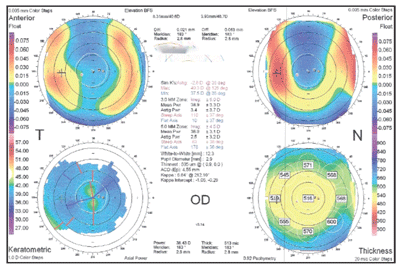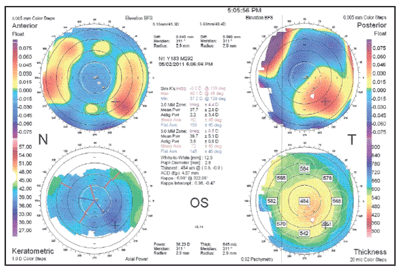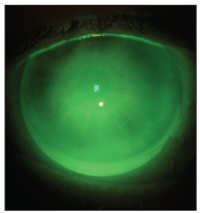 Diurnal variation in vision in post-radial keratotomy (RK) patients are not uncommon.1 Managing these fluctuations with glasses or soft lenses is usually not adequate because the prescription may vary throughout the day. Gas-permeable (GP) lenses are often the best option for these patients because they can correct irregular astigmatism and the tear layer compensates for changes in corneal curvature.2
Diurnal variation in vision in post-radial keratotomy (RK) patients are not uncommon.1 Managing these fluctuations with glasses or soft lenses is usually not adequate because the prescription may vary throughout the day. Gas-permeable (GP) lenses are often the best option for these patients because they can correct irregular astigmatism and the tear layer compensates for changes in corneal curvature.2
Unfortunately, lens tolerance for this group of patients can be a challenge due to the oblate corneal shape and areas of irregularity around the wound sites, which often lead to areas of sensitivity to lens wear. For this group of patients, the increased availability of scleral lens designs is particularly helpful as the lenses vault over potentially sensitive corneal tissue and the fluid chamber can easily accommodate fluctuations in corneal curvature and sag without significantly impacting the lens fit.
This month’s column follows the fitting of one such patient. Next month’s column will describe a different scenario where this patient’s daughter needed an alternative fitting process.
A Case Study

1. Orbscan topography O.D.
J.P. is a 78-year-old white male with a history of RK O.U. (1993), subsequent PRK in the right eye (2003, 2007 and 2008), astigmatic keratotomy (2007), and cataract and intraocular lens implant surgery (2007). He presented to my office for a contact lens fitting in the hopes of improving his visual fluctuations. He said that his vision was quite good first thing in the morning, but that by late morning, his vision would deteriorate and stay blurry the remainder of the day. He had no ocular symptoms other than his vision and had worn contact lenses prior to having RK.
His entering acuity without correction was 20/60 O.D. and 20/40-2 O.S. at 4:15 p.m. He noted that his vision felt blurry, as was typical in the afternoon, and that he recalled his vision being measured at 20/25 in each eye at early morning appointments in the recent past. His pupils were small in each eye, measured at 2mm. All other entrance testing was normal. A refraction of -2.00 + 2.50 x 90 improved his vision in the right eye to 20/25-2, while the left eye had no measured refractive error.
Slit lamp exam revealed RK and AK scars on each eye with no signs of complication, as well as an intraocular lens implant with a clear visual axis in each eye. Orbscans of each eye demonstrated typical post-surgical oblate patterns (figures 1 and 2).
At this point we discussed his options—glasses with a correction, soft lenses or GP lenses to be used when his vision deteriorated. His ophthalmologist had recently recommended that he avoid further surgical intervention, so we did not pursue any of those options. After weighing the pros and cons of each option, J.P. decided to be fitted in scleral GP lenses.
The fitting process was fairly straightforward. Utilizing the recommended starting point for each eye from the fitting guide, a lens was placed on each eye, degree of vault was determined, over-refraction performed and peripheral lens fit assessed. The right eye required moving to a deeper vault lens than the initial trial, while the left lens looked good centrally with the initial lens. Due to the reverse geometry shape of the cornea, an increased mid-peripheral vault was determined to be a better fit than the standard mid-peripheral vault. The standard edge on both lenses looked appropriate, with no signs of blanching of the conjunctival vessels and, therefore, no need to move to a flatter edge design.

2. Orbscan topography O.S.
The final parameters of the scleral lens fitting were (figure 3):
• O.D.: Msd 18.0mm, 4.60 Sag, increased vault, -7.00, standard edge.
• O.S.: Msd 18.0mm, 4.40 Sag, increased vault, -5.00, standard edge.
His visual acuity with each eye individually was a sharp 20/20 and was 20/15 O.U. J.P. was thrilled with the vision and comfort of the lenses, and was very adept at insertion and removal.
The lenses were ordered and dispensed with the fit and vision as expected. He wears the lenses daily from late morning until late evening and is extremely happy with the clarity of vision, as well as the stability of the vision from morning to evening. In fact, he was happy enough to refer his daughter to me, who had also had RK and was also experiencing vision fluctuations, but we will discuss her case next month.
Post-RK patients can, at times, be a challenge to fit due to the complex curvature of their corneas, their vision fluctuations and the propensity for sensitive areas on their corneal surfaces where irregular wound healing may have occurred. While soft lenses and corneal GP lenses can work for some of these patients, fluid-ventilated scleral lenses can be a tremendous option due to the nature of the way the lenses fit. A lens that vaults over the irregular cornea and wound sites, holds a fluid reservoir that allows for corneal curvature changes throughout the day without affecting the lens fit, and can give perfect centration with ideal optics can solve many—if not all—the problems that these patients face.

3. Msd lens fit O.S.
In certain cases, a reverse geometry lens design may need to be employed if available, depending on the lens design being utilized.
1. McDonnell PJ, Nizam A, Lynn MJ, Waring GO; The PERK Study Group. Morning-to-evening change in refraction, corneal curvature, and visual acuity 11 years after radial keratotomy in the prospective evaluation of radial keratotomy study. Ophthalmology. 1996 Feb;103(2):233-9.
2.Alió JL, Belda JI, Artola A, et al. Contact lens fitting to correct irregular astigmatism after corneal refractive surgery. J Cataract Refract Surg. 2002 Oct;28(10):1750-7.


